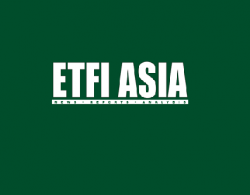
Momentum continuing in ETF and ETP industry, Asia ranking first in growth
Global ETFs and ETPs have reached an annual compounded growth rate of 26.5% over the last ten years, and are up 12.9% year-to-date (YTD) with US$132 billion of net new assets, according to the ETFGI monthly Insight report reviewing end of July 2012 data. The industry had 4,722 products with 9,597 listings and assets of $1.72 trillion from 203 providers with ETFs listed on 54 exchanges.
The US segment is the biggest, with $1.2 trillion in assets or 70% of the global assets. Assets have grown at a 25.9% compounded annual growth rate over the past ten years, and YTD is up 14%, slightly more than what we’ve seen globally this year. When you look at growth, it’s important to remember that asset growth is influenced by net new assets, as well as whether the markets have seen positive moves in a particular year compared with previous years.
It’s also useful to consider the money going into ETFs versus other products. According to Strategic Insight, active mutual funds saw net outflows of $62.5 billion during the first half of 2012, while our data shows ETFs and ETPs had net inflows of $76.5 billion in the same period.
The US accounts for 70.2% of the $ 1.7 trillion in global assets, Europe 18.5% and Asia Pacific (ex-Japan) 4%, leaving 7.3% for the rest of the world. The top three industry providers collectively captured 68.8% of global AUM with iShares taking 38.6%, State Street with 17.7% and Vanguard 12.5%. There is a 9.1% gap between third and fourth place – PowerShares with 3.4% of global AUM and the remaining 199 managers captured just slightly more than a quarter of the assets.
Through the end of July, $131 billion of net new assets (NNA) has flowed into ETFs and ETPs globally which is $17 billion more than this time last year. The top three firms based on AUM competition are also winning the majority of NNA accounting for 62% of all of the NNA, with Vanguard’s accounting for 26.1%, iShares’ 24% and SPRD with 12.4%.
YTD through end of July 2012, net inflows into ETFs and ETPs reached $131 billion, greater than the $114 billion net inflows over the same period in 2011.
Net inflows into products tracking equity benchmarks are broadly similar to the previous year, reporting marginally higher $76 billion net inflows by end of July 2012 compared to $73 billion YTD through end of July 2011.
Fixed income ETFs and ETPs have accumulated more than twice as many net new assets than had been achieved over the same period in 2011 with net inflows of $41 billion versus $18 billion YTD through end of July 2011. At $41 million, net inflows into fixed income products equal 90% of the entire full year 2011 net inflows of $46 billion.
Net inflows into ETFs and ETPs providing exposure to commodities reached $6 billion YTD through end of July 2012, less than the $11 billion of net inflows gathered during the same period in 2011.
YTD through end of July 2012, active ETFs and ETPs gathered $2.9 billion net inflows, marginally higher than the net inflows of $2.5 billion gathered over the same period in 2011.
Globally, 67% of assets are invested in equity benchmarks, 17% in fixed income while commodities are at 12%. Active ETFs are 0.5% of global assets. There are also levered, inverse and currency funds, which are smaller segments.
Looking at Asia ex-Japan at the end of July 2012, there were 400 ETFs/ETPs with their primary listing in Asia ex-Japan, with 518 total listings, assets of $69 billion (counting only primary listing AUM), from 88 providers on 14 exchanges. The compounded annual growth rate has been 31% over the past ten years and is up 21.8%, which is much greater than the global and US growth rates this year.
Trading volumes were highest on the Korea Stock Exchange during July 2012 with $565 million in average daily turnover from ETFs and ETPs, representing 52.1% of all ETF and ETP turnover in Asia Pacific (ex-Japan). In second place was the Shanghai Stock Exchange with $183 million in average daily turnover and 16.9% market share, followed by Hong Kong Stock Exchange with $166 million and a 15.3% market share.
Article link: http://etfiasia.com/component/content/article/39-news/355-the-etf-observer-deborah-fuhr
